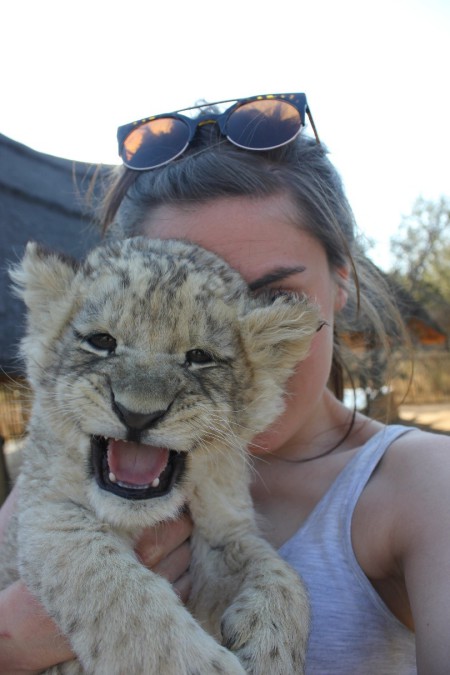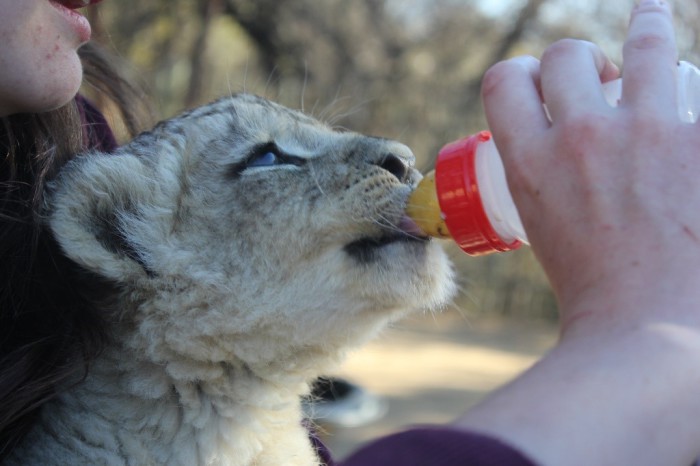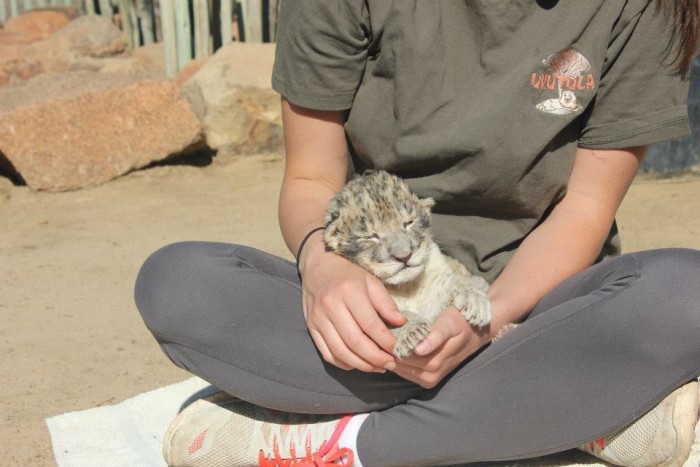I had been an animal lover – more specifically, a cat lover – since I was little. So, when I finished school, it seemed only logical to sign up for an animal-focused volunteering trip – especially volunteering with lions. Written by Lucy Stewart
I found Real Gap, a company centred around sending students abroad. Amongst their top trips was the ‘Live with Lion Cubs’ experience at Ukutula – a fortnight in South Africa with hands-on experience helping to rehabilitate lions, all in the name of conservation. The two-week volunteering with lions experience cost £1,118 (ZAR25,689 at the time), excluding flights, but it seemed like such a good cause that I didn’t mind putting all my savings towards it.
Before the trip, I was not at all clued up about the canned hunting business. I knew all about poachers and trophy hunting, but that didn’t strike me as being related to what I was about to do. I posted a tweet expressing my excitement about the trip and received a message from a girl urging me to avoid Ukutula and that the reserve was affiliated with canned hunting. I was distraught but managed to convince myself that it was an online troll. The idea played on my mind, however, and I sent a message to a representative at Real Gap querying the reserve, but their response was just what I needed to ease my mind – they were disgusted at the very idea of canned hunting and assured me that the trip was solely for the sake of conservation.
On arriving at the reserve in July 2014, I was more excited than ever. The reserve itself was beautiful, located in Brits, just outside of Johannesburg. We were shown to our room, which was in the ‘Devils’ enclosure – a small hut surrounded by 26 three to six-month-old lion cubs.
There were eight volunteers in my group, who had all booked through the same company, along with another 25 volunteers, some of whom had been to Ukutula before. On the reserve at the time were four young cubs, which we cared for on cub duty. The environment seemed welcoming enough, but the staff were sometimes incredibly rude, and any questions regarding the animals were dismissed and scorned. For volunteers with no experience, to be treated like this was a bit off-putting.

In our duties of cleaning enclosures, however, I began to feel slightly uneasy. The female cheetah’s enclosure was small and overgrown, and she was alone in there for 24 hours a day. This did not make sense to me as the reserve was supposedly based on white lion conservation, so why was the cheetah there? The same situation applied to two tigers, which were fully grown and pacing back and forth in their enclosure. We were told that the tigers were mistreated when they were younger and would not survive in the wild alone. There were also two hyenas, which belonged to the owner’s son, who was one of the rangers there. These hyenas were treated like pets, but whenever we cleared their small and sparse enclosure, they would run the entire length of the enclosure back and forth in a straight line, looking utterly demented. It was heartbreaking, but the rangers assured us that this was their natural behaviour and that they were ‘fairly stupid creatures’ anyway.
One of the workers on the reserve, a chef in the kitchen, had two pet caracals, which were kept in a small and unnatural enclosure. He assured us that they were small enough animals for this; he told us they “had all the space they need – they wouldn’t need any more.”
We were also shown two newborn cheetah cubs, which were kept alone in a tiny enclosure. We were not told very much about these two cubs and were not allowed to enter their enclosure – only pet them through the bars. This was something else we found strange, but when asked, the rangers were extremely vague and never quite answered our questions about where the cubs came from or what would happen to them.

The volunteers were to take on cub duty for a large part of their stay, and this involved feeding, bathing and stimulating the four young lion cubs of about two months old to pass urine and faeces. These cubs were available for guests who would come in to play with the animals. There were roughly two or three tours a day of about a dozen or so members of the public, including some very young children. They would stay in the enclosure for about 20 minutes, passing the cubs around and posing for photographs. Any questions from the public were answered with the same scripted speeches – about conservation and how it was beneficial for cubs to interact with humans. However, the cub petting experience did not seem to be for any other reason than novelty and enjoyment.

Cub duty was basically carrying out the jobs which the mother usually does, as the cubs were so young they could not yet look after themselves. We were required to prepare the milk formula and feed the young cubs. Bathing them involved gently dunking them into a tub of warm water and soap and scrubbing the lower half of their body before drying them off. The cubs did not enjoy this one bit, and we were scratched to bits.


When we arrived at the reserve, there was a five-day-old cub that still had his eyes closed and was unable even to walk yet. We were given the surreal opportunity to care for this cub while posing for photos and passing this tiny creature around like a toy. He was not available for the cub petting with the paying members of the public, but towards the end of my time at Ukutula, the owner started to show him off to the public. At night, he was kept indoors with the owners, but if requested, any of the volunteers were able to have him stay in their room overnight.

The cub was taken from its mother and when we questioned this, we were assured that it was for his own good, and it was to be released into the wild when it grew up. Volunteers are often told that these cubs are orphans or in danger of being attacked or eaten by the other lions and can only be raised in this environment. Again, this is obviously false. At the end of my two-week stay, the little cub was moved into the other enclosure to interact with the four other young lion cubs there, and I assume this was the beginning of his ‘cub petting’ days.
Interacting so closely with a lion cub may seem like a very difficult thing to turn down. However, parks that offer ‘cub petting’ cannot be associated with promoting the welfare and conservation of lions. These cubs are passed around between volunteers and paying customers with no animal care experience until they are too big to cuddle, by which point they are so used to human interaction that they would not survive in the wild.
At Ukutula, after they grow out of cub petting, they are moved into the ‘Devils’ enclosure, where there are huts for volunteers to stay in so that they get to see lions right outside their window. These lions were around four to six months old and had to be fed from a distance. Rangers and volunteers would prepare the food, which involved studding what looked like fairly rotten chickens with a nutrient and calcium formula known as ‘Predator Powder’. These chickens were then thrown over the fence into the enclosure, and each lion would grab what it could. The volunteers were told never to get too close or go into the enclosure when the lions were feeding, as they would become aggressive.
When the lions reached around nine months to one-and-a-half years old, they were then moved into an area known as the ‘Gremlins’. There were around 30 ‘Gremlins’ in one enclosure, and there was more than one enclosure on the reserve – racking up quite a high number of lions in this age group. These enclosures were basic squares of dust, with a watering pool and some trees for shade – a fairly grim sight to look at, but the rangers ensured us it was temporary and they would be ‘soon released’.
These lions were trained to partake in ‘lion walks’ in which volunteers and paying customers are given waist-height wooden sticks to use as ‘warnings’ against the animals, should they get too close. We were told never to bend down below waist height, as the lions could pounce on us – but this seemed to be the only safety precaution. Throughout the walk, we stopped at various trees and areas where we could pose for photographs. The lions were coerced back and forth with bits of chicken in order to get a good shot and look at the camera. The rangers also used chicken and sticks to get the lions to climb up into the trees for the best photo opportunity. We were told this was natural behaviour.

When the lions have grown past the ‘lion walk’ stage and reached adulthood – at around three years old – the volunteers lose track of them. We are told they are released into the wild, which is laughable, come to think of it. These animals are so used to human contact, as it is all they have known, and would never survive in what should be their natural environment. The harsh reality is that these animals will be sold – perhaps to zoos, private owners, or canned hunting middlemen.
Looking back now, I feel the most anger towards the owners of the lodge. There was a meeting called between all of the volunteers and staff in our first couple of days, during which the owner told us how they had bought the reserve years ago and were breeding lions, and ‘much to their surprise and disgust’ were receiving requests regarding the hunting of their lions. They then told us how, unbeknown to them, they had bought into the canned hunting business, at which time they cut off all ties and turned the lodge into ‘Ukutula’ – meaning ‘place of quiet’, a peaceful place to promote breeding and conservation. The apparent ‘research’ being carried out on the reserve was not explained fully to the volunteers, but the general idea was conveyed that Ukutula was attempting to increase the number of white lions by breeding them on-site in a protected environment – away from poachers – and releasing them into the wild when old enough.

It was not until maybe a year after I returned home when a friend who had been in my group shared a post that everything changed, and I discovered the truth. I was utterly distraught. It had not only all been a sham, but I had been part of something that I had wanted to explicitly prevent – the hunting and unethical treatment of these beautiful creatures. I immediately wrote furious emails to Real Gap, Ukutula, and anyone who would listen, but I got very little response. I kept sending more and more messages to Real Gap, and a few months later, received another message from a friend saying the trip had been removed from the website.
Reading this, it may seem I was incredibly naïve, but at the time, these places offered incredibly convincing cover stories. I feel sick to my stomach at the thought of it, but can only use this negative experience in a positive way. Making people aware of these issues is so important, and I aim to do everything I can to ensure that this does not happen to any more volunteers looking to help.
Malena Persson, from Campaign Against Canned Hunting UK, concludes: “When I read about Lucy’s experiences, the full scale of the canned hunting operations hit me – these poor individuals are being harshly duped into repressing what little suspicions they have. They get entirely caught up in the long string of lies that they are being fed over and over. Ugly lies are hidden behind cuteness, as lion cubs are dangled in front of the volunteers to take their eyes and minds off their gut feeling that something is very, very wrong. Lion farms are clever; they bring up the horrors of canned hunting before anyone even asks about it, assuring their volunteers that they are indeed the good guys and that they would never have anything to do with that kind of appalling cruelty. Lion breeding facilities abuse the trust of genuinely goodhearted young people. Many volunteers go to South Africa because they want to help; they want to save lions. But instead, they end up supporting one of the biggest frauds of our time. And it is about time that everyone sees captive breeding of lions for what it is – it is the first step in the canned hunting chain; it is deception with a deadly end.”
To comment on this story: Login (or sign up) to our app here - it's a troll-free safe place 🙂.![]()






